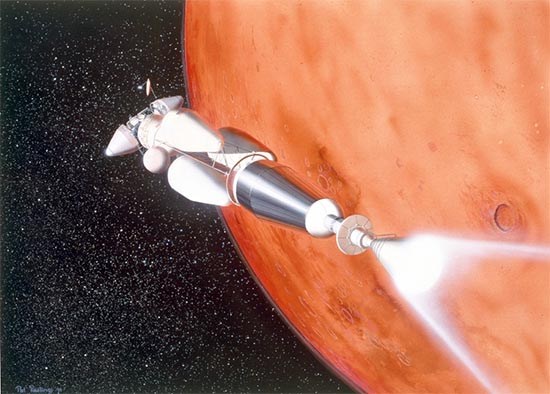Russian Nuclear Powered Ion Space Propulsion System
Last week, I blogged about using lasers and space sails for the propulsion of spacecraft. This week, I am going to talk about using nuclear fission for space propulsion. I have mentioned nuclear fission propulsion engines in the past. The Soviet Union was very interested in nuclear engines for space travel and created a functional nuclear engine after a twenty year program that started in 1960 and ended in 1980. It was never used to propel any spacecraft. In the U.S., Project Orion was a design for a spacecraft that used nuclear propulsion that was never built. The Russians are currently working on a new nuclear fission propulsion system.
The most recent Russian nuclear propulsion project was launched in 2010 with a budget of about two hundred and seventy five million dollars. It was part of the Russian space program planning for the period up to 2020. The goal was to develop a nuclear fission-based propulsion system that would provide much greater economic efficiency by increasing the amount of electricity available on a spacecraft by ten times. It is hoped that this will allow deep space mission of greater duration and distance. The funding was split among a number of different organizations and facilities.
The new system is to include "high-conversion circuits , a high temperature compact fast reactor with a gas cooling system, nuclear and radiation safety features for in all phases of operation, high temperature turbine and compact heat exchangers with a decade of design life, high-speed electric generators with high power converters, high efficiency fuel cells, and a propulsion system based on high-performance powerful ionic electric propulsion."
In the this new Russian system, a nuclear reactor generates up to four megawatts of electricity which heats a gas that then drives a turbine. The turbine generates electricity with high efficiency which is used to charge fuel cells. An ion propulsion system then uses the electricity available to send charged ions of xenon gas out the back of the space craft. There will be six main engines and eight smaller engines for roll control and course correction.
Ion propulsion is not as immediately powerful as chemical rockets but it operates continuously for long periods of time. This is much more efficient than chemical rockets and it requires much less fuel. Unlike current rocket engines which fire intensely for short periods and then shut off leaving the spacecraft to coast for long periods, the new propulsion system would be able to maneuver, accelerate and decelerate during the flight.
The head of the Russian Rosatom nuclear corporation just announced that Russia may test a prototype of their new nuclear propulsion engine for space exploration as soon as 2018. Conventional rockets would take more than six months to reach Mars and would not be able to carry enough fuel to make the return trip. The new Russian nuclear propulsion system should be able to reach Mars in about six weeks and return to Earth without refueling.
Traditional rocket engines and traditional fuels are reaching the end of their utility for deep space missions and the Russians are betting that nuclear propulsions systems will be the next "big thing" in space propulsion. The U.S. recently tested the first use of ion engines in orbit and they are being considered for U.S. deep space missions.
Artist's concept of a Russian spacecraft with nuclear driven ion propulsion:
